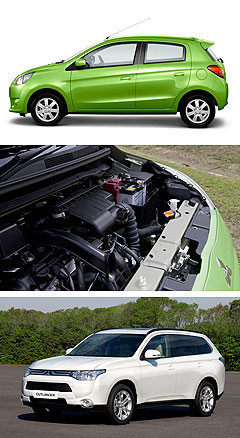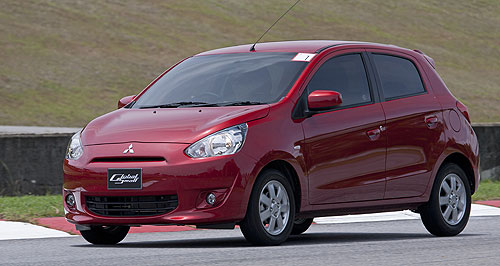Future models - Mitsubishi - MirageMitsubishi’s low-tech directionGoing so-low: Mitsubishi’s Global Small program that spawned the Mirage ditches expensive technologies in favour of engineering fundamentals, but the company admits this poses a risk in mature markets. Low-tech approach and unique styling puts Mitsubishi at risk of orphaning Mirage24 May 2012 By HAITHAM RAZAGUI in BANGKOK THE achievement of low weight, low fuel consumption and low cost in Mitsubishi’s Mirage light car represents a “new direction” for the company that involves the judicious use of low-tech solutions, while it pursues a pioneering path for other products in its line-up such as the next-generation Outlander SUV. Heightening the risk of orphaning the Mirage – also known as Global Small – with this approach, Mitsubishi corporate general manager for the Global Small project Takashi Sato told journalists in Bangkok yesterday that he does not think the front-end styling applied to the aerodynamically designed Mirage is likely to be seen anywhere else in the range. The Mirage’s three-cylinder engine has no direct fuel injection – even though Mitsubishi pioneered the technology in modern mainstream cars in the 1990s – the manual transmission has only five ratios, the rear brakes use drums instead of discs and there is no reach adjustment for the steering. Mr Sato said the Mirage employs a simplified platform with no provision for all-wheel drive, four-cylinder engines or diesels. “Previously Mitsubishi has developed a lot of new technology, GDI (gasoline direct-injection) the first in the world, of course we have a lot of technology for four-wheel-drive, we have diesel,” he said. “That is one direction we have had until now and this time we are seeking a different direction not resulting in expensive technologies. “We put a lot of effort in the fundamentals of the technology area and realised the low-cost cut in fuel consumption.” Mr Sato said the adoption of this philosophy across other models depends on whether the Mirage is successful, but that Mitsubishi’s intention is not to test the market with this product.  From top: Mitsubishi Mirage Mitsubishi Outlander SUV. From top: Mitsubishi Mirage Mitsubishi Outlander SUV.“My intention is not to test the market. Management considered it is not always good what we have done until now, therefore we have to consider the different direction, that is the basic idea.” He insisted it was not necessary to use expensive direct-injection systems on the Mirage, pointing out that its engine’s hybrid-like CO2 output matches that of the direct-injection-equipped Nissan Micra sold in Europe. The Mirage, which is built at a new factory in Thailand – where it recently went on sale and demand has exceeded expectations – was developed with emerging markets in mind, but its fuel-efficiency and low cost is also intended to appeal to mature markets like Australia. Mr Sato agreed that one reason for not using direct injection was its incompatibility with the poor-quality fuel found in some of its target markets. He understands the low-tech, low-cost concept may not be accepted in mature markets used to the latest technical developments, but suggested the car’s fuel efficiency speaks for itself and customers will find appeal in the value-for-money on offer. “(Gaining acceptance in mature markets) is our biggest task. I understand the concept I have explained today may not be accepted so easily in a mature market. “We have put a lot of energy (into) the fundamental technology of this vehicle, for example the weight is very light, almost 10 per cent lighter than the competitors and the aerodynamics are very good. “In the Japanese market the fuel consumption level of this vehicle is better than hybrids, without any expensive, sophisticated technologies.” One area in which Mitsubishi did opt for costlier, more sophisticated technology on the Mirage was the automatic transmission. Mr Sato said a CVT is more expensive but was required for reducing consumption. “From the fuel consumption point of view the contribution of the transmission is very important, much more than the engine itself, therefore as far as the transmission is concerned, though the CVT cost is a bit higher than the traditional (torque-converter type), we determined to pay money for that.” Asked whether customers would accept the use of a CVT over a traditional automatic, Mr Sato said there were “a lot of different opinions”, but that CVT was the best choice in order to offer good fuel consumption. “From a driveability point of view, CVT can be accepted by most of the customers because we can choose shift patterns as we like. We have tried so that the driveability (and) the shift feeling of the CVT is close to what is anticipated by the customer.” Mitsubishi had to increase production of the Mirage just weeks after it launched in Thailand due to higher than expected demand, with more than 23,000 units ordered since the books opened at the end of March, so Mitsubishi’s direction is clearly being accepted, in this market at least. “As far as we see (with) the market in Thailand, they have accepted our concept and we want to sell this vehicle not only in mature markets but also in rising markets. We have the feeling that in rising markets this concept can be accepted, but of course there is the risk for example in Europe that they will not accept (it).”  Read moreAll future models Alfa Romeo Alfa Romeo Abarth Abarth Audi Audi Aston Martin Aston Martin BMW BMW Bentley Bentley Chrysler Chrysler Chevrolet Chevrolet Dodge Dodge Citroen Citroen Ferrari Ferrari DS DS Ford Ford Fiat Fiat FPV FPV Foton Foton Haval Haval Great Wall Great Wall Honda Honda Holden Holden Hyundai Hyundai HSV HSV Isuzu Isuzu Infiniti Infiniti Jeep Jeep Jaguar Jaguar Lamborghini Lamborghini Kia Kia Lexus Lexus Land Rover Land Rover Mazda Mazda Maserati Maserati Mercedes-Benz Mercedes-Benz McLaren McLaren Mini Mini Nissan Nissan Mitsubishi Mitsubishi Peugeot Peugeot Opel Opel Proton Proton Porsche Porsche Renault Renault Ram Ram Saab Saab Rolls-Royce Rolls-Royce Smart Smart Skoda Skoda Subaru Subaru SsangYong SsangYong Tesla Tesla Suzuki Suzuki Toyota Toyota Volvo VolvoMirage pricingMotor industry news |
Click to shareMitsubishi modelsResearch Mitsubishi All future models Alfa Romeo Alfa Romeo Abarth Abarth Audi Audi Aston Martin Aston Martin BMW BMW Bentley Bentley Chrysler Chrysler Chevrolet Chevrolet Dodge Dodge Citroen Citroen Ferrari Ferrari DS DS Ford Ford Fiat Fiat FPV FPV Foton Foton Haval Haval Great Wall Great Wall Honda Honda Holden Holden Hyundai Hyundai HSV HSV Isuzu Isuzu Infiniti Infiniti Jeep Jeep Jaguar Jaguar Lamborghini Lamborghini Kia Kia Lexus Lexus Land Rover Land Rover Mazda Mazda Maserati Maserati Mercedes-Benz Mercedes-Benz McLaren McLaren Mini Mini Nissan Nissan Mitsubishi Mitsubishi Peugeot Peugeot Opel Opel Proton Proton Porsche Porsche Renault Renault Ram Ram Saab Saab Rolls-Royce Rolls-Royce Smart Smart Skoda Skoda Subaru Subaru SsangYong SsangYong Tesla Tesla Suzuki Suzuki Toyota Toyota Volvo VolvoMirage pricingMotor industry news |
















Facebook Twitter Instagram